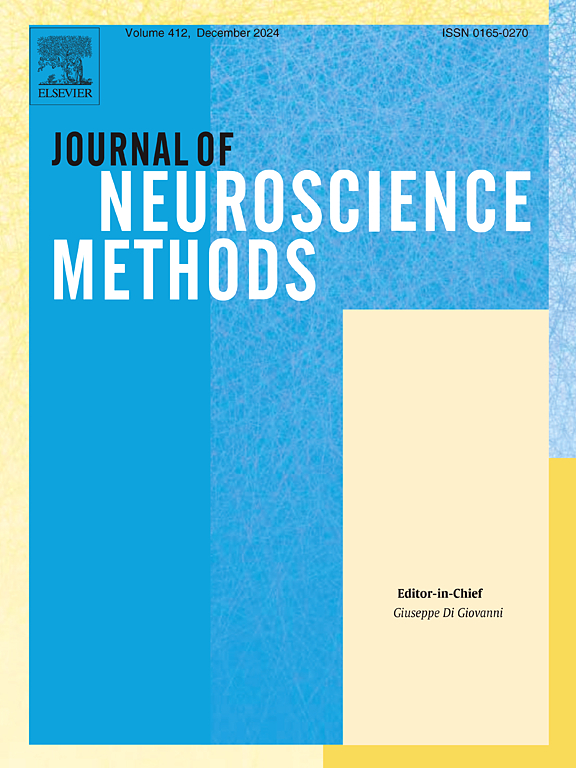基于人工智能的可卡因自控狨猴行为和大脑图像分析。
IF 2.7
4区 医学
Q2 BIOCHEMICAL RESEARCH METHODS
引用次数: 0
摘要
背景:非人灵长类动物(NHPs)具有复杂的行为和认知能力,适合作为可卡因自我给药(SA)计划的研究对象。然而,由于伦理方面的考虑、对 3R 原则(替代、减少和完善)的遵守以及其他因素,要获得用于研究的非人灵长类个体具有挑战性。因此,我们需要能利用人工智能(AI)全面分析小型数据集的方法:我们利用人工智能从收集到的数据中识别可卡因依赖模式。首先,我们收集了可卡因SA狨猴(Callithrix jacchus)的行为数据,以开发依赖性预测模型。使用SHAPLE Additive exPlanations(SHAP)值来证明各种变量的重要性。此外,我们还收集了显示多巴胺转运体(DAT)结合电位的正电子发射断层扫描(PET)图像,并开发了PET图像分割算法:预测模型显示,随机森林(RF)算法表现最佳,曲线下面积(AUC)为 0.92。利用 SHAP 值确定了影响模型的前五个变量。PET 图像分割模型的准确率为 0.97,平均平方误差为 0.02,交集大于联合(IoU)为 0.845,Dice 系数为 0.913:利用狨猴 SA 实验的数据,我们开发了一个基于 ML 的依赖性预测模型,并利用 SHAP 分析了变量重要性排名。基于人工智能的成像分割方法为评估慢性可卡因给药后NHPs的DAT可用性提供了一种有价值的工具。本文章由计算机程序翻译,如有差异,请以英文原文为准。
Artificial intelligence-based analysis of behavior and brain images in cocaine-self-administered marmosets
Background
The sophisticated behavioral and cognitive repertoires of non-human primates (NHPs) make them suitable subjects for studies involving cocaine self-administration (SA) schedules. However, ethical considerations, adherence to the 3Rs principle (replacement, reduction and refinement), and other factors make it challenging to obtain NHPs individuals for research. Consequently, there is a need for methods that can comprehensively analyze small datasets using artificial intelligence (AI).
New methods
We employed AI to identify cocaine dependence patterns from collected data. First, we collected behavioral data from cocaine SA marmosets (Callithrix jacchus) to develop a dependence prediction model. SHapley Additive exPlanations (SHAP) values were used to demonstrate the importance of various variables. Additionally, we collected positron emission tomographic (PET) images showing dopamine transporter (DAT) binding potential and developed an algorithm for PET image segmentation.
Results
The prediction model indicated that the Random Forest (RF) algorithm performed best, with an area under the curve (AUC) of 0.92. The top five variables influencing the model were identified using SHAP values. The PET image segmentation model achieved an accuracy of 0.97, a mean squared error of 0.02, an intersection over union (IoU) of 0.845, and a Dice coefficient of 0.913.
Comparison with existing methods and conclusion
Utilizing data from the marmoset SA experiment, we developed an ML-based dependence prediction model and analyzed variable importance rankings using SHAP. AI-based imaging segmentation methods offer a valuable tool for evaluating DAT availability in NHPs following chronic cocaine administration.
求助全文
通过发布文献求助,成功后即可免费获取论文全文。
去求助
来源期刊

Journal of Neuroscience Methods
医学-神经科学
CiteScore
7.10
自引率
3.30%
发文量
226
审稿时长
52 days
期刊介绍:
The Journal of Neuroscience Methods publishes papers that describe new methods that are specifically for neuroscience research conducted in invertebrates, vertebrates or in man. Major methodological improvements or important refinements of established neuroscience methods are also considered for publication. The Journal''s Scope includes all aspects of contemporary neuroscience research, including anatomical, behavioural, biochemical, cellular, computational, molecular, invasive and non-invasive imaging, optogenetic, and physiological research investigations.
 求助内容:
求助内容: 应助结果提醒方式:
应助结果提醒方式:


